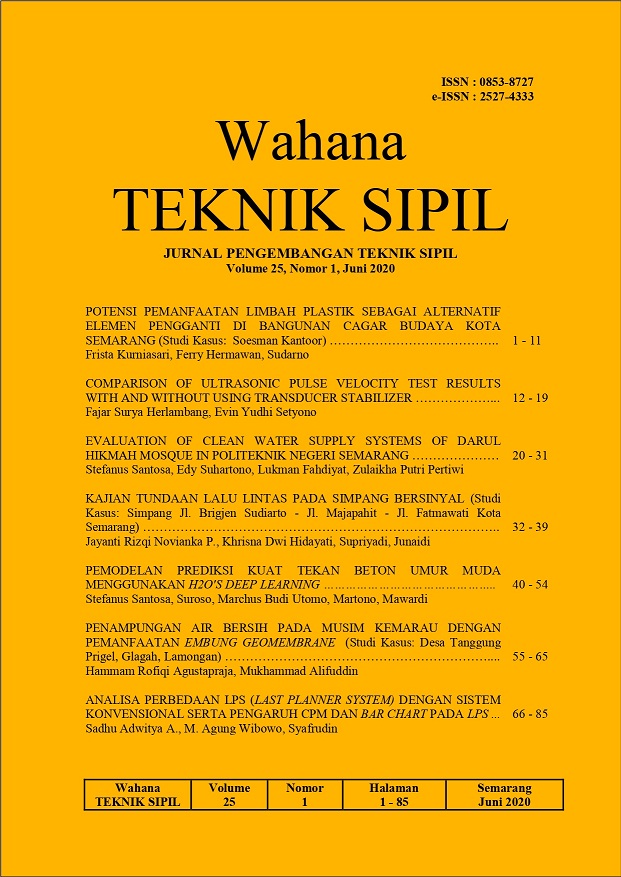POTENSI PEMANFAATAN LIMBAH PLASTIK SEBAGAI ALTERNATIF ELEMEN PENGGANTI DI BANGUNAN CAGAR BUDAYA KOTA SEMARANG (Studi Kasus: Soesman Kantoor)
DOI:
https://doi.org/10.32497/wahanats.v25i1.1913Keywords:
Plastic waste, heritage building, alternative materialAbstract
Indonesia as the second largest contributor in global were produced about 9.52 million tons plastic or 14% of the total waste. The rapid population growth of urban area in Indonesia indirectly encourages various activities that affect the volume of waste. Semarang city were contributing waste in landfills reaches 850,000 tons per day, where 1,000 tons unmanageable. Unsorted garbage has the potential as new materials option in cultural heritage buildings. To elaborate these potential options, this research has been conducted qualitative method as the best approach to answer the research question. This research investigates the stakeholders”™ perspectives about potential of plastic waste for replacement material of heritage buildings. The results show that there is a lack of data on waste management which is one of the challenges to find out how much volume of plastic waste can be reused. In addition, the principle of building cultural heritage is opposed to the use of plastic waste as an alternative material as a substitute element. In conclusion, plastic waste has a little potential from current waste to be applied on heritage buildings are limited element such as roof, furniture or temporary support of the structural element.
References
Jambeck, J. R., Geyer, R., Wilcox, C., Siegler, T. R., Perryman, M., Andrady, A., Law, K. L., 2015, Plastic waste inputs from land into the ocean. 5. ScienceMag.com (Diakses Januari 2019)
Lamb, J. B., Willis, B. L., Fiorenza, E. A., Couch, C. S., Howard, R., Rader, D. N., Harvell, C. D., 2018, Plastic waste associated with disease on coral reefs. Science, 359(6374), 460”“462
Lu, W., Chen, X., Ho, D.C.W., Wang, H., 2016, Analysis of the construction waste management performance in Hong Kong: the public and private sectors compared using big data. J. Clean. Prod. 112, 521”“531.
MacRae, G., Rodic, L., 2015, The weak link in waste management in tropical Asia? Solid waste collection in Bali. Habitat Int. 50, 310”“316.
Rahardjo, Mudjia, 2017, Studi kasus dalam penelitian kualitatif: konsep dan prosedurnya. Researh Repository Universitas Islam Negeri Maulana Malik Ibrahin Malang. Teaching Resources.
Republik Indonesia, 1999, Peraturan Daerah Khusus Ibukota Jakarta No.9 Tahun 1999.
Seghiri, M., Boutoutaou, D., Kriker, A., & Hachani, M. I., 2017,The Possibility of Making a Composite Material from Waste Plastic. Energy Procedia, 119, 163”“169.
Silva, A., Rosano, M., Stocker, L., Gorissen, L., 2017, From waste to sustainable materials management: Three case studies of the transition journey. Waste Manag. 61, 547”“557.
Sistem Informasi Pengelolaan Sampah Nasional. http://sispn.menlhk.go.id. (Diakses 5 Maret 2019)
Vizoso, Ferra, 2017, Restoration of the old Church of Corbera d”™Ebre, Terra Alta, Tarragona. http;//www.divisiare.com. (Diakses 21 Maret 2019)
World Bank Group, 2018, Kementerian Koordinator Bidang Kemaritiman., Embassy of Denmark., Royal Norwegian Embassy. Laporan Sintesis: Hotspot Sampah Laut Indonesia.
Zambrana-Vasquez, D., ZabalzaBribián, I., Jáñez, A., & Aranda-Usón, A., 2016, Analysis of the environmental performance of life-cycle building waste management strategies in tertiary buildings. Journal of Cleaner Production, 130, 143”“154.
Downloads
Published
Issue
Section
License
Authors who publish with this journal agree to the following terms:Authors retain copyright and grant the journal right of first publication with the work simultaneously licensed under a Creative Commons Attribution License that allows others to share the work with an acknowledgement of the work's authorship and initial publication in this journal.
Authors are able to enter into separate, additional contractual arrangements for the non-exclusive distribution of the journal's published version of the work (e.g., post it to an institutional repository or publish it in a book), with an acknowledgement of its initial publication in this journal.
Authors are permitted and encouraged to post their work online (e.g., in institutional repositories or on their website) prior to and during the submission process, as it can lead to productive exchanges, as well as earlier and greater citation of published work (See The Effect of Open Access).






